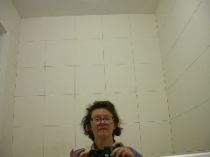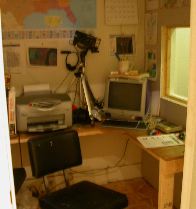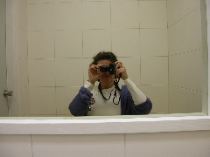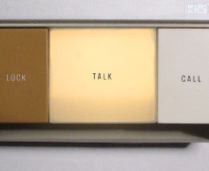 I love interactive sculpture. There’s something about putting my body on the line in the duty of art that appeals to the art soldier in me.
I love interactive sculpture. There’s something about putting my body on the line in the duty of art that appeals to the art soldier in me.
Thus, when I stepped into Bridgette Mayer gallery Friday night and found objects that called out for my touch — something I wasn’t expecting — I was a happy girl. Mayer, who usually shows wall-based paintings and prints pulled out all the stops for this, her first foray into exhibiting sculpture.
It’s a four-person show, with work by Scot Kaplan, Brant Ritter, Mike Stifel and Scott White. I’ll talk about Kaplan’s work first and save comments on Ritter, Stifel and White’s work for another post.
 Scot Kaplan‘s “R21” is a threatrical set piece that involves two connected interrogation booths that have the look and feel of the real thing. One room is a sterile white box with a mirror, a table and chair. The other is a dark office loaded with multiple computers and cameras. At the opening, Kaplan played the interrogator and I hopped into the white box, ready for my grilling. (top image is from inside my half of R21. Right is the surveillance equipment in the other half.)
Scot Kaplan‘s “R21” is a threatrical set piece that involves two connected interrogation booths that have the look and feel of the real thing. One room is a sterile white box with a mirror, a table and chair. The other is a dark office loaded with multiple computers and cameras. At the opening, Kaplan played the interrogator and I hopped into the white box, ready for my grilling. (top image is from inside my half of R21. Right is the surveillance equipment in the other half.)
It was hot in there and the few moments I sat facing myself in the two-way mirror while Kaplan set up his equipment gave me ample time to consider how these things work in the real world. I snapped a few pictures and knew that my time in the box would be short-lived. But what if that door was locked and I was prevented from getting out? What if this encounter were to have consequences beyond “art?” Had I done anything recently that I needed to worry about in our Ashcroftian homeland? Any unpaid parking tickets? Any red lights I slid through that somebody caught on video? How about those two “Notice of Baggage Inspection” cards placed inside my suitcase by the TSA in the last two out of three of my trips by airplane. Is somebody watching me?
I’ve never been in a police interrogation room and usually I don’t go into rooms without windows except to get out a coat or a pair of shoes. I thought about the children in Pepon Osorio‘s “Trials and Turbulence” installation at ICA and how they have encounters in box-like rooms with people trying to extract information from them. Those interviews may even be for the childrens’ own good, but it probably doesn’t feel like it. And of course I thought of Ilya Kabakov‘s theatrical installations that are all about the smallness and vulnerability of one in an inflexible, paranoia-fueled system.
 Kaplan, professor of art at Ohio State University (via MFA at University of Pennsylvania and five years in New York) told me he created this piece to raise issues about the communication of information–that which is given freely and that which is extracted by other means. He wants to make viewers aware of what’s going on in the world of spyware and what’s permissible under things like the Patriot Act (a copy of which you can read right there in the gallery). (image is me fighting back with my camera)
Kaplan, professor of art at Ohio State University (via MFA at University of Pennsylvania and five years in New York) told me he created this piece to raise issues about the communication of information–that which is given freely and that which is extracted by other means. He wants to make viewers aware of what’s going on in the world of spyware and what’s permissible under things like the Patriot Act (a copy of which you can read right there in the gallery). (image is me fighting back with my camera)The piece makes use of an intercom system between the two rooms. Push the “talk” button when speaking or you won’t be heard. Kaplan, who kept his voice robotic and uninflected, asked me to state and spell my name. It was an inocuous question that started the journey. (button pictured below)
Then, courtesy his software program, “PRIVATE EYE,” the artist told me my address, my husband’s name, the names of some former neighbors. That was somehow not surprising, albeit a little troubling. We are all vulnerable to computer spying. It is just a matter of who’s looking and for what.
Kaplan’s questions got more interesting after that, getting into murkier, morally questioning territory as the artist/interrogator started asking me to pass judgment on some of the information he came up with.

Did I think my former neighbors were trustworthy? Was there any reason he shouldn’t contact them…or my husband.
You can see where this is going — right into the land of guilt and spill the beans. For not only is this an environment about two people, but it’s an environment where one can tattle on others. By asking leading questions, some with an insinuating edge, the interrogator could unleash a confession that’s far more than just the facts, ma’m. And indeed, Kaplan told me that in testing the piece out he’d found people ready to divulge plenty.
Outside the booth, Kaplan placed a wall of clipboards with information about spying (“how to” information if you’re so inclined) and about citizens’ rights (to protect yourself). I was told by the artist that during the course of the show viewers will be able to enter both sides of the confessional and participate as either interrogator — or sinner.
I suggest a visit — to experience both sides of the piece. The show’s up to Oct. 30.









